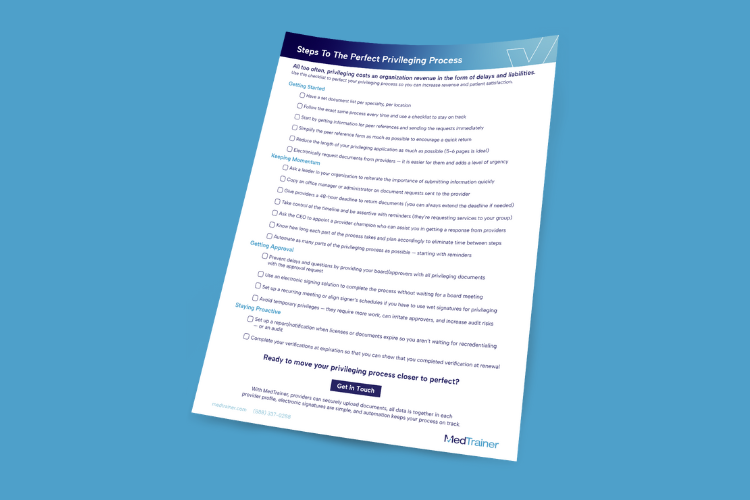If you have an efficient process, healthcare privileging really can be done in 30 days.
Your organization’s revenue may depend on it.
The average revenue per orthopedic case is $3,719. If delays in the privileging process force a provider to miss even three or four procedures, that can be $10,000 in lost revenue.
At Rocky Mountain Surgical Center, we’ve made several updates and have fine-tuned our entire credentialing process. Here is some insight into what we’ve learned and implemented.

Shorten your privileging process with this free checklist.
What Is Privileging in Healthcare?
Privileging requires the provider to prove they are capable of the specific skills they intend to perform. Privileging ensures that individuals act within the scope of their practice and provide competent patient care in line with their role at the facility.
The difference between privileging and credentialing is that the latter ensures that providers have the proper license and documentation to provide treatment. Together, credentialing and privileging create assurances that any healthcare provider hired to do a job is both well-qualified to do what’s expected of them and capable of executing to required standards.
9 Steps To Speed Up Healthcare Privileging
The privileging process can be delayed for any number of reasons — whether it’s waiting on peer references, a missed question on the application, or lack of supporting documentation. Through my experience as a credentialer, here are nine steps that help to keep my privileging applications moving forward.
Step #1: Start Immediately
As soon as I’m notified of a new physician and an initial application is received, I send out peer reference requests. This can be one of the lengthiest parts of the process, and one that I have little control over. I send automated email reminders and get the requesting provider involved when necessary; but sometimes even that isn’t enough. Other pieces of privileging may wait or be staged until these are received as they are such an essential piece of the process. Though the wait often gives time to prep the remaining pieces for board approval.
Step #2: Keep the Application Short
One of the best things our team did is reduce the length of our application by nearly half. The application is now only five or six pages of critical information. We include one page that requests the information needed specifically for National Practitioner Data Bank (NPDB) queries. We eliminated as many repetitive pieces as possible and limited the application to essential information which keeps it manageable for providers to complete in a quick time frame. Not having repetitive information also helps to keep the provider on track and focused on the task including any needed supporting documentation.
Step #3: Electronically Request Documents
Using credentialing software has been one of our biggest time savers. We have prepared applications and a list of required documents per location, per speciality, so when a new provider is added, an email request is automatically sent for them to securely upload their documents and complete the appropriate application. Using an online format eliminates the printing and scanning that often causes delays for providers. The electronic document request and application is official and recognizable so there’s automatically a greater level of urgency and the facility stands out over the other privileging applications that the provider needs to complete.
Step #4: Be Assertive With Reminders
Don’t forget that the provider is requesting privileges at your facility. It’s a two-way street — you want them, but they need you as well. Don’t hesitate to require the information you need and give a firm deadline. Using credentialing software that automatically sends email reminders until all required documents are collected takes a huge burden off your shoulders. I’ve found that sometimes providers respond better to the system asking than myself. It puts the responsibility on the process rather than the person.
Step #5: Eliminate Time Between Tasks
This is one of the ways that I can make up time as it falls within my control. Remember, even a three to four day delay can cost an organization anywhere from $10,000-$20,000. Using a set checklist is really helpful to stay on track even with other responsibilities or many privileging processes going on at once. I always know exactly where I am in the process and what’s coming next because I have something standardized to refer to.
Step #6: Complete PSV and Privileging Delineation
Collecting and verifying documents can be tedious, but everything else you do depends on this information being complete and correct. This is our most efficient area and the one that I have the most control over. I use a preset list of speciality specific privilege options within the application. It gives me more control, streamlines privilege delineation, and improves accuracy.
Step #7: Get Board Approval Electronically
I provide all privileging documents to board members when I ask for their approval. Some of our board doesn’t need to see this information, but I know that other board members will review it carefully. By providing it upfront, you’re saving time in your process — and for your board. We’re all busy, so sending the information and collecting signatures electronically offers a much more streamlined process than trying to get signatures in person.
Step #8: Avoid Temporary Privileges
Temporary privileges enable your organization to earn revenue faster, but you’re also costing the company money by duplicating the process as well as staff and Board time to review all requests. Temporary privileging can be appropriate in some situations; but it’s best to complete a full application review, verification, and privileging whenever possible to eliminate repeat work and overall save time and money for both your practice and the provider.
Step #9: Continually Update
I update documents and licenses as they expire, so when it is time to handle re-appointment, I only have one or two items to update. Ongoing review and updates also help us to remain in compliance with AAAHC. Surveyors have reviewed the time between the document becoming effective and completion of verification, so it’s important to show consistency and accuracy. Make sure it’s on time and not months (or years!) in between.
Streamline the Privileging Process With Credentialing Software
Credentialing software is absolutely essential to manage the privileging process. All provider data and documents are stored in provider profiles and notifications are sent when licenses are expiring and providers are due for recredentialing. It’s easy to pull reports with this information so I always know what my workload is 60 to 90 days ahead.
See if MedTrainer Credentialing Software could be a fit for your organization.
